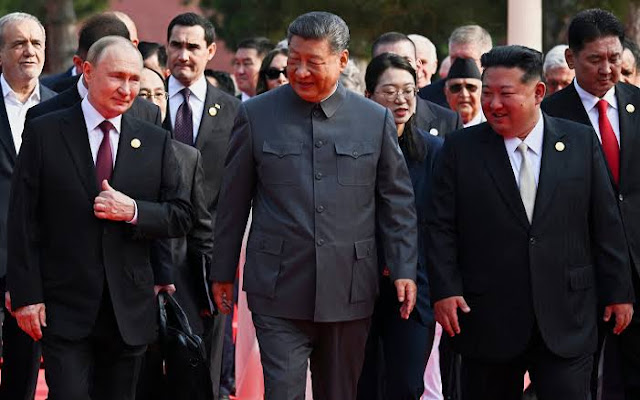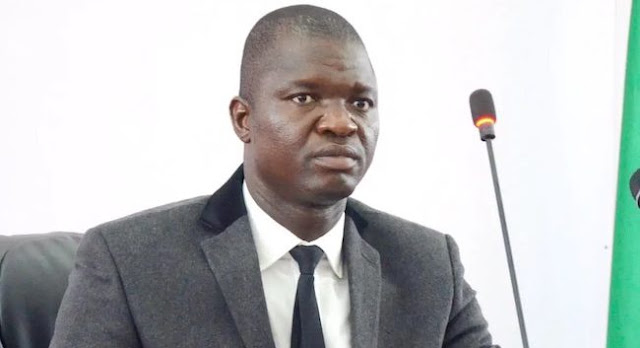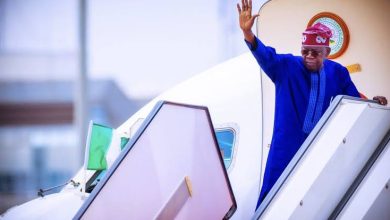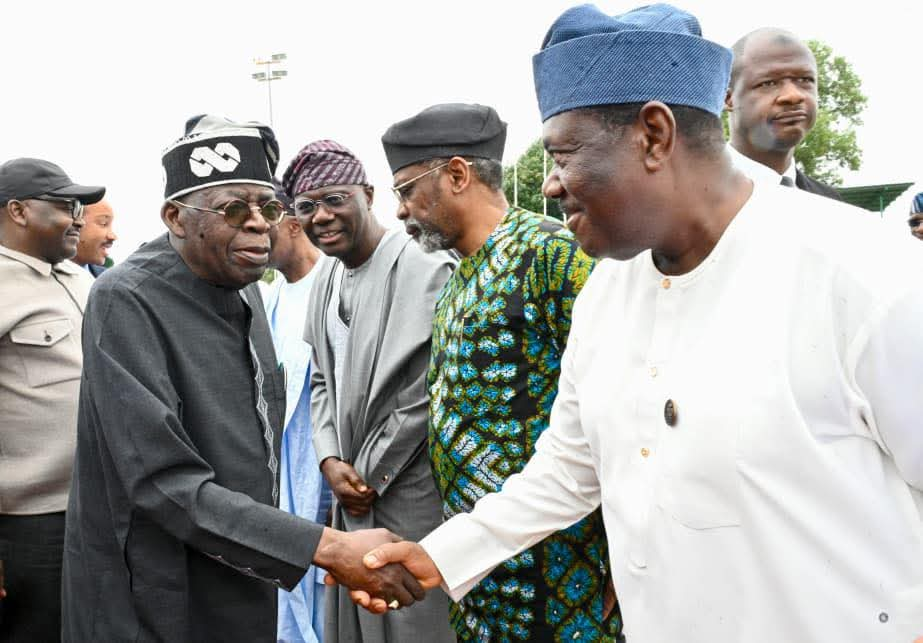On September 3, 2025, Beijing’s Tiananmen Square was transformed into a grand stage of military might, national pride, and diplomatic symbolism as China hosted a massive parade to commemorate the 80th anniversary of the victory in the Chinese People’s War of Resistance Against Japanese Aggression and the World Anti-Fascist War. The event, presided over by Chinese President Xi Jinping, marked a rare and historic moment: the first public meeting of Xi, North Korean leader Kim Jong Un, and Russian President Vladimir Putin. This trio, representing three of the world’s most prominent authoritarian powers, stood together atop the Gate of Heavenly Peace, sending a powerful message of unity and defiance to the Western-led global order. The parade, attended by other foreign leaders and dignitaries, was a meticulously choreographed display of China’s military prowess and its strategic alignment with allies who share a vision of countering U.S. dominance. This article delves into the details of the event, the historical and geopolitical context, the significance of the leaders’ public appearance, and the broader implications for global politics.
The Event: A Spectacle of Power and Unity
The military parade in Beijing was a dazzling display of China’s military modernization and national pride. Held on September 3, 2025, under clear skies, the event drew thousands of spectators to Tiananmen Square, where 15,000 troops, hundreds of military vehicles, and dozens of aircraft showcased China’s technological and strategic advancements. The parade began at 10 a.m. local time with a ceremonial raising of the national flag, followed by the national anthem. Rows of People’s Liberation Army (PLA) soldiers marched in precise formations, their synchronized steps reverberating across the square. Advanced weaponry, including intercontinental ballistic missiles (ICBMs) like the DF-41, hypersonic missiles, and next-generation drones, rolled through the streets, while J-20 stealth fighters and bombers roared overhead, leaving trails of red and yellow smoke.
The parade was not just a military spectacle but a carefully orchestrated diplomatic event. The presence of Kim Jong Un and Vladimir Putin, alongside Xi Jinping, was a focal point, symbolizing a rare alignment of three leaders who have increasingly coordinated their foreign policies to challenge Western influence. The Chinese Foreign Ministry announced that 26 heads of state and government attended, including Pakistan’s Prime Minister Shehbaz Sharif and Myanmar’s junta chief Min Aung Hlaing. However, the spotlight was on Kim, Putin, and Xi, whose joint appearance atop the Tiananmen rostrum was a powerful image broadcast across the globe. The event was covered extensively by Chinese state media, such as Xinhua and CCTV, which framed it as a celebration of historical victory and a reaffirmation of anti-fascist solidarity.
Kim Jong Un arrived in Beijing on September 2, 2025, aboard his armored green train, a mode of transport synonymous with North Korea’s secretive leadership. Accompanied by a young girl believed to be his daughter, Kim Ju Ae, his arrival was warmly received by Chinese officials, including Foreign Minister Wang Yi. Putin, meanwhile, arrived via his presidential aircraft, greeted with similar pomp and ceremony. The leaders’ interactions, including a reported bilateral meeting between Xi and Kim, underscored the deepening ties among their nations. The parade’s historical focus on the 1945 victory over Japan provided a unifying narrative, linking their shared histories of resisting external aggression to their contemporary geopolitical strategies.
Historical Context: The War and Its Legacy
The parade commemorated the 80th anniversary of the end of the Chinese People’s War of Resistance Against Japanese Aggression (1931–1945), a pivotal chapter in China’s modern history. The conflict began with Japan’s invasion of Manchuria in 1931 and escalated into a full-scale war by 1937, marked by atrocities such as the Nanjing Massacre. The war, part of the broader World Anti-Fascist War, cost China millions of lives—estimates suggest over 14 million deaths—and left deep scars on the national psyche. The victory in 1945, when Japan surrendered to the Allied forces, was a turning point, ending a century of humiliation at the hands of foreign powers and paving the way for the founding of the People’s Republic of China (PRC) in 1949.
For China, the war is a cornerstone of its national narrative, emphasizing resilience, unity, and the Chinese Communist Party’s (CCP) role in leading the resistance. The parade’s historical focus resonated with domestic audiences, reinforcing the CCP’s legitimacy as a force of national salvation. For North Korea, the war holds similar significance, as Kim Il Sung, the country’s founding leader, led guerrilla campaigns against Japanese forces, a legacy central to the Kim dynasty’s mythology. Russia, too, shares this historical narrative, having fought Japan in the final days of World War II, securing territorial gains in the Far East. The parade’s theme of anti-fascist solidarity thus provided a shared platform for the three leaders to project unity, drawing on historical grievances to frame their current alignment against perceived Western aggression.
The 2025 parade built on previous commemorations, such as the 2015 event for the 70th anniversary, which also saw foreign leaders, including Putin, in attendance. However, the 2025 gathering was unique due to the presence of all three leaders and the heightened geopolitical tensions of the time. The event was not just a look back at history but a forward-looking statement of intent, signaling a coordinated effort to reshape global power dynamics.
The Leaders: Profiles and Motivations
Xi Jinping: The Architect of China’s Rise
Xi Jinping, China’s paramount leader since 2012, has positioned himself as the architect of the country’s “national rejuvenation.” Under his leadership, China has pursued an assertive foreign policy, modernized its military, and expanded its global influence through initiatives like the Belt and Road Initiative. The parade was a showcase of Xi’s vision, blending historical pride with contemporary power. His speech from the Tiananmen rostrum emphasized China’s contributions to the anti-fascist struggle and its commitment to peace, while subtly warning against challenges to its sovereignty, particularly in the South China Sea and Taiwan.
Xi’s decision to host Kim and Putin was strategic. China, facing trade disputes and strategic competition with the United States, benefits from aligning with like-minded powers. The parade provided a platform to project unity, countering Western narratives of isolation. Xi’s warm reception of Kim, including a personal expression of hospitality, reaffirmed China’s role as North Korea’s primary patron, while his interactions with Putin highlighted their “no-limits” partnership, formalized in 2022.
Kim Jong Un: The Defiant Dynast
Kim Jong Un, North Korea’s leader since 2011, is known for his provocative rhetoric and relentless pursuit of nuclear capabilities. His rare international trips—only 10 since taking power—reflect his cautious approach to diplomacy, driven by security concerns and the need to maintain domestic control. The Beijing visit, his first to China since 2019, was significant, not least because he was accompanied by his daughter, Kim Ju Ae, whose presence sparked speculation about succession.
Kim’s attendance at the parade served multiple purposes. Domestically, it bolstered his image as a global statesman, reinforcing the Kim dynasty’s legitimacy. Internationally, it signaled North Korea’s alignment with China and Russia, particularly in the context of its growing military ties with Moscow. Kim’s interactions with Xi and Putin, including a reported bilateral meeting, underscored his strategic maneuvering to secure economic and military support amid crippling sanctions.
Vladimir Putin: The Anti-Western Crusader
Vladimir Putin, Russia’s president since 2000 (with a brief interlude as prime minister), has pursued a foreign policy centered on challenging Western dominance. His invasion of Ukraine in 2022 and subsequent defense pact with North Korea in 2024 have deepened Russia’s isolation from the West, making alliances with China and North Korea critical. The parade offered Putin a platform to project strength, despite Russia’s ongoing challenges in Ukraine and economic sanctions.
Putin’s presence alongside Xi and Kim was a visual affirmation of their shared resistance to U.S.-led global governance. His interactions with Kim, building on their 2023 summit at a Russian spaceport, highlighted Russia’s reliance on North Korean military support, including troops and munitions for the Ukraine war. For Putin, the Beijing parade was an opportunity to reinforce his narrative of a multipolar world, with Russia, China, and North Korea as key players.
Geopolitical Implications: A New Axis of Power?
The public meeting of Xi, Kim, and Putin was a potent symbol of a growing alignment among authoritarian powers. This “trilateral summit” was not a formal alliance but a demonstration of shared interests in countering Western influence. The geopolitical context of 2025 amplified its significance. The United States, under a new administration following the 2024 election, was navigating a complex global landscape. President Donald Trump’s return to power brought unpredictability, with his expressed interest in engaging with Kim Jong Un contrasting with his administration’s hardline stance on China.
China-North Korea Relations
China and North Korea share a long-standing alliance, formalized by the 1961 Treaty of Friendship, Cooperation, and Mutual Assistance. China remains North Korea’s primary economic and political lifeline, providing trade and aid despite international sanctions. The parade reaffirmed this “traditional friendship,” as noted by Chinese Assistant Foreign Minister Hong Lei. However, China’s relationship with North Korea is complex, with Beijing wary of Pyongyang’s provocative actions, such as missile tests, that could destabilize the region.
Kim’s visit, accompanied by his daughter, signaled North Korea’s desire to strengthen ties with China, particularly as it deepens its military partnership with Russia. For Xi, hosting Kim was a balancing act, reinforcing China’s role as a regional hegemon while managing North Korea’s unpredictability. The parade provided a controlled environment to project unity without committing to new obligations.
Russia-North Korea Partnership
The Russia-North Korea relationship has grown significantly since the Ukraine war began. In 2024, Kim and Putin signed a defense pact pledging mutual military assistance, a move that alarmed the U.S. and its allies. North Korea’s deployment of troops to support Russia’s war efforts, as confirmed by a propaganda video on August 31, 2025, has further deepened this partnership. The parade offered a public stage for Kim and Putin to showcase their alignment, with their interactions signaling a commitment to further cooperation.
This partnership poses challenges for China, which values regional stability and has been cautious about North Korea’s growing ties with Russia. The parade, however, allowed Xi to position himself as the senior partner in this trilateral dynamic, mediating between Kim’s unpredictability and Putin’s strategic ambitions.
U.S. and Western Responses
The image of Xi, Kim, and Putin together was a stark message to the West, particularly the United States. The U.S., alongside allies like Japan and South Korea, has sought to counter China’s influence through alliances such as the Quad and AUKUS. The parade likely prompted discussions in Washington about strengthening deterrence in the Indo-Pacific. The Biden administration’s successor, whether Trump or another leader, faces the challenge of responding to this alignment without escalating tensions.
South Korea and Japan, both present at the parade through lower-level representatives, expressed unease. South Korea, in particular, is concerned about North Korea’s military support for Russia, which could embolden Pyongyang’s nuclear ambitions. Japan, wary of China’s regional assertiveness, may push for closer coordination with the U.S. to counter this trilateral alignment.
Kim Ju Ae’s Presence: A Succession Signal?
A notable subplot of the event was the presence of Kim Ju Ae, believed to be Kim Jong Un’s daughter, marking her first public international appearance. Little is known about Ju Ae, whose existence was first confirmed by Dennis Rodman in 2013. Estimated to be a preteen or early teen, she has appeared at military events in North Korea since 2022, fueling speculation that Kim is grooming her as a potential successor. Her presence in Beijing, walking behind her father on a red carpet, was a deliberate move to introduce her to the world stage.
For North Korea, Ju Ae’s appearance signaled continuity and stability in the Kim dynasty, a critical message given Kim Jong Un’s health concerns and the regime’s reliance on dynastic legitimacy. Her exposure to Xi and Putin suggests that North Korea is preparing her for a future role in navigating its key alliances. The parade’s historical focus provided a fitting backdrop, linking her to the Kim family’s revolutionary legacy.
Domestic and Regional Impacts
For China, the parade was a domestic triumph, reinforcing national pride and the CCP’s legitimacy. Xi’s speech, emphasizing China’s historical sacrifices and modern strength, resonated with a population facing economic challenges, such as slowing growth and youth unemployment. The presence of Kim and Putin bolstered China’s image as a global leader, capable of rallying allies against Western pressure.
In North Korea, state media portrayed Kim’s visit as a diplomatic victory, highlighting his interactions with Xi and Putin. The inclusion of Ju Ae furthered the narrative of dynastic continuity, strengthening the regime’s domestic legitimacy. For Russia, the parade was a chance to project resilience despite Western sanctions, with Putin’s presence alongside Kim signaling a deepening anti-Western axis.
Regionally, the event heightened tensions. South Korea and Japan, both U.S. allies, are likely to accelerate military modernization and coordination with Washington. The parade’s display of Chinese and North Korean military capabilities, coupled with Russia’s involvement, may prompt a reevaluation of security strategies in the Indo-Pacific.
Global Media and Public Reactions
The parade garnered extensive global media coverage. Western outlets, such as BBC and CNN, focused on the geopolitical implications, framing the Xi-Kim-Putin meeting as a challenge to the U.S.-led order. Chinese state media emphasized historical unity and anti-fascist solidarity, while Russian outlets highlighted the event as evidence of a multipolar world. Social media platforms, including X, buzzed with reactions, ranging from speculation about Ju Ae’s role to debates about the parade’s military displays.
Public sentiment varied. In China, patriotic fervor dominated, with netizens praising the PLA’s discipline and Xi’s leadership. In North Korea, tightly controlled media ensured positive coverage, while in Russia, the event was seen as a counterpoint to Western isolation. Western audiences expressed concern about the growing alignment of authoritarian powers, with some calling for stronger diplomatic and military responses.
Broader Themes: History, Power, and Resistance
The Beijing parade encapsulated broader themes of history, power, and resistance. The historical narrative of the anti-fascist struggle provided a unifying framework, allowing Xi, Kim, and Putin to draw parallels between past victories and their current opposition to Western influence. The parade’s military displays underscored their collective power, with China’s advanced weaponry signaling its emergence as a superpower, North Korea’s presence highlighting its nuclear defiance, and Russia’s participation reflecting its resilience.
Resistance to Western hegemony was a central motif. The leaders’ public meeting was a visual rebuke to sanctions, alliances, and policies aimed at containing their influence. The parade also highlighted the role of historical memory in shaping national identity, with each leader leveraging the 1945 victory to justify their contemporary agendas.
Conclusion
The public meeting of Xi Jinping, Kim Jong Un, and Vladimir Putin on September 3, 2025, was a historic moment that reverberated across the globe. The Beijing parade, with its blend of military might, historical commemoration, and diplomatic symbolism, was a stage for these leaders to project unity and defiance. For Xi, it was a triumph of China’s global ambitions; for Kim, a chance to bolster his regime’s legitimacy; and for Putin, an opportunity to counter Western isolation.
The event’s implications are profound. It signals a deepening alignment among authoritarian powers, challenging the U.S.-led order and raising questions about the future of global governance. Kim Ju Ae’s presence added a layer of intrigue, hinting at North Korea’s succession plans. As the world navigates an increasingly polarized landscape, the Beijing summit will stand as a defining moment, highlighting the complexities of power, history, and resistance in the 21st century.






